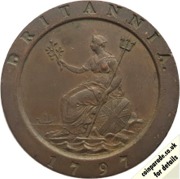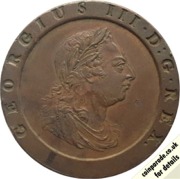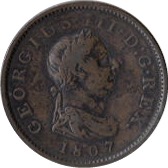
 The 1797 Cartwheel Penny - George III
The 1797 Cartwheel Penny - George III The 1797 Penny is one of the most remarkable coins in British history. Its size earned the coin its nickname of the 'Cartwheel' penny. It has a diameter of 36mm, it is 3mm thick and weighs 28.35g. Compared to a modern penny it is almost twice the diameter, twice the thickness and a staggering eight times heavier! SCBC 3777.
Why was the 1797 Cartwheel Penny so large?
Back in the latter part of the 18th Century, gold and silver were shooting up in price. This affected the gold Guinea and also the lower denomination silver coins. This made silver coins too expensive to use in small value coins which resulted in a general lack of small change to page wages.
By the late 1780s pennies and halfpennies were being minted by private companies. Although not actually legal tender, these 'tokens' were widely used.
To make matters worse, this was the time of the Industrial Revolution and many individuals had a small press and the technical ability to manufacture coins. Copper was cheap and by the 1790s maybe 90% of the British copper coinage was counterfeit.
Eventually, the British government asked Birmingham Industrialist Matthew Boulton to use his private mint in Soho, Birmingham to strike official British coins. Boulton, who had James Watt as a business partner, would use steam power for the first time to create British coinage.
The government gave Boulton 480 tonnes of copper to make pennies, and another 20 tonnes to make twopences. Because of the high level of forgeries, it was stipulated that a penny had to contain one penny's worth of copper. This created a physically huge coin as one penny could purchase about one ounce of copper.
A coin of such a size turned out to be difficult to produce even for steam powered machines, and the batch was still being made in 1798 and 1799, although all the coins were dated 1797.
Obviously too large and heavy for everyday use, Merchants didn't like the coins and no more Cartwheel pennies or twopences were made at the Soho factory, although in 1799 Boulton did have a follow up order for halfpennies and farthings and later on minted smaller pennies.
Matthew Boulton offered a complete service and had his own artist/engraver, Conrad Heinrich Küchler, to design both sides of the coin. Küchler (1740-1810) was a German engraver who came to England in 1793 and was employed by the Soho Mint.
The Reverse shows Britannia, but not sitting on rocks as in previous depictions but on the waves of the sea with a ship in the distance. The impression is that Britain rules the waves. Britannia holds a trident in one hand and an olive branch in the other. Look closely below the shield, in the waves you can see 'SOHO' engraved in it.
There is a deeply raised rim on both sides of the coin. The coin has a plain edge.
 The Obverse is a bust of King George III.
The Obverse is a bust of King George III.There are a number of variations. The wreath may contain 10 or 11 leaves. The other variants are concerning alloys and finish - copper, copper proof, gilt copper proof, bronzed proof, silver proof and gold proof. The proofs are rare and can be expensive.
There are still plenty of Cartwheel pennies around, and you can get worn ones from a few pounds. Be careful at the top end as there are many replicas floating about. If the coin looks mint (with lustre) then be wary as this condition is very rare. Our advice, as always, is that if you are spending any big money then use a trusted dealer.
Images used by permission of M J Hughes Coins.
Mintage: Not known
Minted at Private Mint
More information (monarch, year, mint, country, category) can be found below coin listings.
Below are some coins currently being offered on eBay. As an eBay Partner, We may be compensated if you make a purchase.
List items on:
List items on:
Remember 1797 ?
Monarch is King George III. Prime Minister is William Pitt the Younger (Tory). US President is George Washington (no political party); on 4th March it is John Adams (F-Massachusetts). The copper "Cartwheel" twopence coins pressed, for the only time, at Boulton and Watt's Soho Mint, Birmingham. Bank of England notes are inconvertible to gold, it is the 'Restrictive Period'. The Bank issues the first one-pound and two-pound notes (the £1 remains in issue until 11 March 1988). Horatio Nelson is Knighted.
George III (1760-1820)
 Born on 4 June 1738 to Frederick, Prince of Wales and Augusta of Saxe-Gotha in the house of Hanover, George III reigned for over 59 years.
Born on 4 June 1738 to Frederick, Prince of Wales and Augusta of Saxe-Gotha in the house of Hanover, George III reigned for over 59 years.George had 15 children - nine sons and six daughters. In the latter part of his life George suffered from a mental illness and his son George became Prince Regent from 1811-1820 and ruled on his behalf. On George III's death, the Prince Regent became George IV.
Note the latin spelling of George on his coins: Georgivs.
Category: Penny
The Penny is one of the most famous British coins. The coin itself has been around since 600AD and at various times has been struck in silver, copper and bronze. Originally split into halfpennies and farthing, it is now itself the least denomination coin currently in circulation. Made from copper (actually copper plated steel). Originally there were 12 pennies in one shilling and 240 pennies in £1; since decimalisation in 1971 there are 100 new pence in one pound.
Composition: Early pennies were Silver, then Copper, Bronze and Copper coated steel.
Which Mint: Private Mint
Private Mints exist all over the World. Some create only commemorative coins, but others do produce legal tender coins for governments.In the 18th Century Matthew Boulton's Soho Mint in Birmingham produced not only tokens but actual British coinage like the Cartwheel Penny and Twopence under contract from the British government.
There are several private mints in the UK operating today, like the Pobjoy Mint.
Country of Origin: United Kingdom
The United Kingdom (UK) is the Union of England, Scotland, Wales and Northern Ireland. It is often refered to as Great Britain (GBR). It has a long, rich history. The orignal coinage was Pounds, Shillings and Pence but since decimalisation on 15 February 1971, it is £1 = 100p, that is One Pound = 100 pence. The coinage of the UK is also a long history, the Royal Mint being established as long ago as 886AD when coins were hammered. Today there is perhaps 30 billion coins in circulation, and many (numismatic) collectors coins and sets are issued frequently in gold, silver and other metals.








